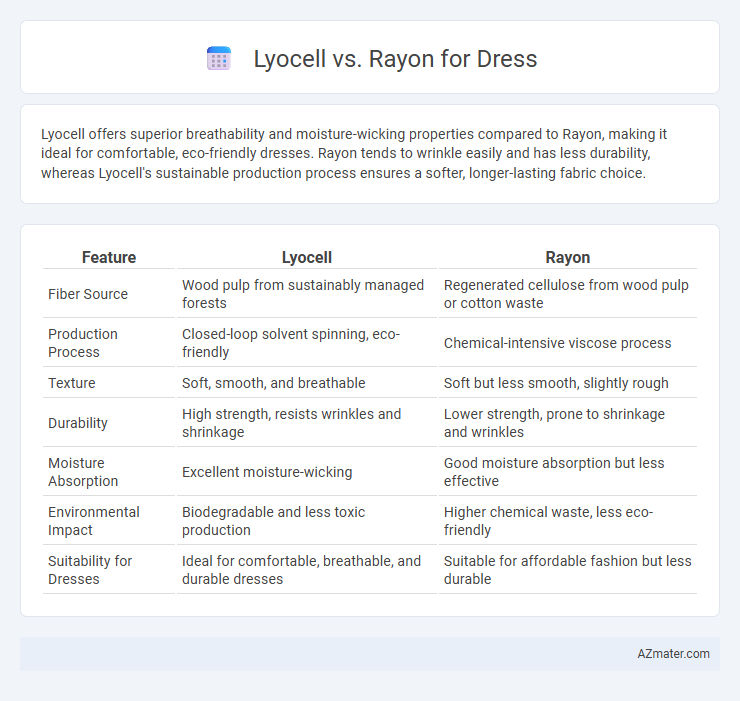Lyocell offers superior breathability and moisture-wicking properties compared to Rayon, making it ideal for comfortable, eco-friendly dresses. Rayon tends to wrinkle easily and has less durability, whereas Lyocell's sustainable production process ensures a softer, longer-lasting fabric choice.
Table of Comparison
| Feature | Lyocell | Rayon |
|---|---|---|
| Fiber Source | Wood pulp from sustainably managed forests | Regenerated cellulose from wood pulp or cotton waste |
| Production Process | Closed-loop solvent spinning, eco-friendly | Chemical-intensive viscose process |
| Texture | Soft, smooth, and breathable | Soft but less smooth, slightly rough |
| Durability | High strength, resists wrinkles and shrinkage | Lower strength, prone to shrinkage and wrinkles |
| Moisture Absorption | Excellent moisture-wicking | Good moisture absorption but less effective |
| Environmental Impact | Biodegradable and less toxic production | Higher chemical waste, less eco-friendly |
| Suitability for Dresses | Ideal for comfortable, breathable, and durable dresses | Suitable for affordable fashion but less durable |
Introduction to Lyocell and Rayon
Lyocell is a sustainable fabric made from wood pulp, typically eucalyptus, processed through an eco-friendly closed-loop system that recycles water and solvents, making it biodegradable and soft with excellent moisture absorption. Rayon, also derived from cellulose fibers, involves a chemical-heavy manufacturing process that affects its environmental footprint, though it remains popular for its smooth texture and affordability. Both fabrics offer breathability and versatility for dressmaking, but Lyocell's durability and eco-conscious production appeal to consumers seeking sustainable fashion options.
Origins and Production Processes
Lyocell is a sustainable fabric derived from wood pulp, primarily eucalyptus, produced through a closed-loop process that recycles almost all chemicals and water, minimizing environmental impact. Rayon, originally developed in the late 19th century, is a semi-synthetic fiber made from cellulose using a viscose process involving toxic chemicals like carbon disulfide, leading to higher ecological concerns. The environmentally friendly production of lyocell contrasts with the chemically intensive rayon manufacturing, influencing their use in eco-conscious dressmaking.
Environmental Impact: Lyocell vs Rayon
Lyocell offers a significantly lower environmental impact compared to rayon due to its closed-loop production process that recycles water and solvents, reducing pollution and resource waste. Rayon, derived from chemically treated cellulose, often involves toxic chemicals like carbon disulfide, which contribute to air and water contamination during manufacturing. Choosing lyocell for dresses supports sustainable fashion by minimizing chemical usage and promoting biodegradable fabric with less ecological footprint.
Fabric Feel and Comfort for Dresses
Lyocell fabric offers a smooth, soft texture with excellent breathability and moisture-wicking properties, making it ideal for comfortable dresses that keep the wearer cool and dry. Rayon, while also soft, tends to feel heavier and less breathable, which can result in less comfort during extended wear, especially in warm climates. The eco-friendly production process of lyocell enhances its appeal by combining comfort with sustainability, giving it an edge over traditional rayon fabrics.
Durability and Longevity Comparison
Lyocell fibers exhibit higher durability than rayon due to their stronger molecular structure and resistance to abrasion, making dresses retain shape and texture longer. Rayon tends to weaken with repeated washing and exposure to moisture, resulting in faster fiber breakdown and shorter garment lifespan. Choosing lyocell for dresses ensures extended wearability and maintains fabric integrity over time, ideal for long-term wardrobe investment.
Moisture Absorption and Breathability
Lyocell offers superior moisture absorption and breathability compared to rayon, making it an ideal fabric choice for dresses in warm and humid climates. Its cellulose fibers efficiently wick moisture away from the skin, promoting faster drying and increased comfort. Rayon, while breathable, tends to retain more moisture and dries slower, resulting in a heavier feel when worn for extended periods.
Color Retention and Dyeing Properties
Lyocell exhibits superior color retention compared to rayon due to its closed-loop production process, which results in a smoother fiber surface that holds dye more effectively and resists fading after multiple washes. Rayon's open fiber structure absorbs dye more readily but is prone to color bleeding and fading, especially under sunlight and frequent laundering. The advanced dyeing properties of lyocell enable vibrant, long-lasting hues ideal for high-quality dresses requiring durability and colorfastness.
Care and Maintenance Requirements
Lyocell dresses require gentle handling, washing in cold water with mild detergent, and air drying to preserve fabric strength and prevent shrinking. Rayon dresses, while soft and breathable, often need dry cleaning or hand washing in cold water to avoid weakening fibers and minimize wrinkling. Proper care of both fabrics extends garment life, but Lyocell's moisture-wicking and resilience make it easier to maintain than delicate Rayon.
Cost Comparison: Lyocell vs Rayon Dresses
Lyocell dresses generally cost more than rayon dresses due to their eco-friendly production process and higher durability. Rayon offers a more budget-friendly option but may sacrifice longevity and environmental benefits compared to lyocell. Consumers seeking sustainable fashion might find lyocell to be a cost-effective investment over time despite the initial higher price.
Which Fabric Is Better for Dresses?
Lyocell offers superior breathability and moisture-wicking properties compared to rayon, making it an ideal choice for comfortable, lightweight dresses. Rayon tends to be more prone to shrinking and weaker when wet, whereas lyocell is stronger and more resistant to wrinkles, ensuring better durability and ease of care. The sustainable production process of lyocell also makes it a more eco-friendly fabric, appealing to environmentally conscious consumers seeking stylish and functional dresses.

Infographic: Lyocell vs Rayon for Dress
 azmater.com
azmater.com